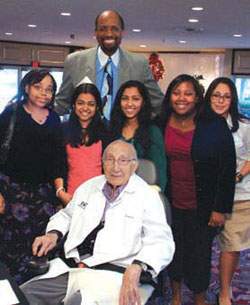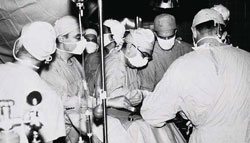
Dr. DeBakey with NLM's David Nash and admiring students from the Michael E. DeBakey High School for Health Professionals in Houston, Texas
Perhaps no person has done more to advance the surgical treatment of diseases of the heart and blood vessels than Dr. Michael DeBakey. Over his unparalleled career, he has operated on more than 60,000 patients, from presidents and celebrities to ordinary citizens the world over. An impassioned patient's advocate, he has continuously urged the support of medical research as the means of discovering improved methods of diagnosis, treatment, prevention, and cure.
As far back as 1965, Dr. DeBakey told Time magazine, "It is deficiencies in materials and our lack of knowledge about how they will work over a long period that are holding us up ... I am confident that if $50 million were made available today for just this kind of research, an artificial heart, or the vital parts of one, could be ready for permanent implantation within three to five years."
As early as 1932, he developed components that became part of the first heart-lung machines. In 1936, he was one of the first to identify a connection between cigarette smoking and lung cancer. In the 1950s, he devised plastic tubing for repairing blood vessels, a treatment he applied to prevent recurring strokes, and kidney failure, and to restore circulation to limbs that mightotherwise have been amputated. For many years, the DeBakey Dacron Graft has been used around the world to replace or repair blood vessels. In 1963, he made history by installing an artificial pump to assist a patient's damaged heart.

Dr. Michael E. DeBakey, shown with his surgical team in the mid-1960s, has operated on more than 60,000 patients, including Russian President Boris Yeltsin, who called him a "magician of the heart."
On December 31, 2005, at age 97, Dr. DeBakey suffered an aortic dissection—a tear in the inner layer of the body's largest artery. This was the very condition that his pioneering procedure was designed to treat. He was hospitalized at The Methodist Hospital in Houston. Dr. DeBakey initially resisted the surgical option, but as his health deteriorated, his operation was approved and on February 10, 2006, he became the oldest patient ever to undergo the surgery for which he was responsible. The operation lasted seven hours and required a complicated postoperative course, including eight months in the hospital. But in September he was released, returned to good health and able to participate at the October ground-breaking of Baylor's new Michael E. DeBakey Library and Museum. In a lengthy Christmas Day interview that year about his operation, he told The New York Times, "I feel very good. I'm getting back into the swing of things."
On September 7 of this year, Dr. DeBakey will celebrate his 100th birthday. His contributions to the field of medicine have spanned more than 75 years.
